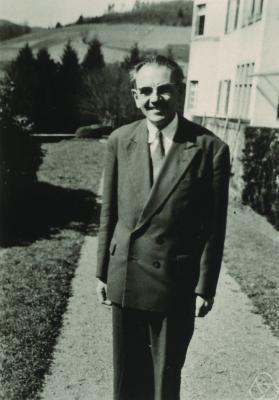Jean Leray facts for kids
Quick facts for kids
Jean Leray
|
|
|---|---|

Jean Leray at Oberwolfach in 1961
|
|
| Born | 7 November 1906 Chantenay-sur-Loire (today part of Nantes)
|
| Died | 10 November 1998 (aged 92) La Baule
|
| Alma mater | École Normale Supérieure |
| Known for | Partial differential equations Algebraic topology Global hyperbolicity Sheaf theory Sheaf cohomology Leray cover Leray projection Leray's theorem Leray spectral sequence Leray–Hirsch theorem Leray–Schauder degree |
| Awards | Prix Francoeur (1937) Malaxa Prize (1938) Feltrinelli Prize (1971) John von Neumann Prize(1962) Wolf Prize (1979) Lomonosov Gold Medal (1988) |
| Scientific career | |
| Fields | Mathematics |
| Institutions | University of Nancy University of Paris Collège de France |
| Doctoral advisor | Henri Villat |
| Doctoral students | Armand Borel István Fáry |
Jean Leray (7 November 1906 – 10 November 1998) was an important French mathematician. He worked on two main areas of math: partial differential equations and algebraic topology.
Contents
Life and Career
Jean Leray was born in Chantenay-sur-Loire, which is now part of Nantes, France. He studied at the École Normale Supérieure from 1926 to 1929. He earned his Ph.D. in mathematics in 1933.
Early Discoveries
In 1934, Leray published a very important paper. This paper started the study of "weak solutions" for the Navier–Stokes equations. These equations describe how fluids, like water or air, move. "Weak solutions" are a special way to find answers to these equations, even when they are very complex.
In the same year, he and another mathematician, Juliusz Schauder, found a new mathematical tool. It is called the Leray–Schauder degree. This tool helps prove that solutions to certain equations exist, even if there might be many possible answers.
Time as a Professor
From 1938 to 1939, Jean Leray was a professor at the University of Nancy. He was friends with the mathematicians who started the Bourbaki group. This was a group of French mathematicians who worked together to write books about modern math. However, Leray did not officially join their group.
Work During World War II
From 1940 to 1945, during World War II, Leray was a prisoner of war. He was held in Edelbach, Austria. During this difficult time, he focused on his work in topology. Topology is a branch of math that studies shapes and spaces.
Leray kept his knowledge of differential equations a secret. He was worried that if his captors knew he understood these equations, they might force him to do war-related work.
His work during this time was very important for developing new ideas in math. These ideas included "spectral sequences" and "sheaves." These tools later became very useful in a field called "homological algebra."
Return to Differential Equations
Around 1950, Leray started working on partial differential equations again. He was a professor at the University of Paris from 1945 to 1947. After that, he taught at the Collège de France until 1978.
Awards and Recognition
Jean Leray received many awards for his contributions to mathematics. Some of these include:
- The Malaxa Prize from Romania in 1938.
- The Grand Prix in mathematical sciences from the French Academy of Sciences in 1940.
- The Feltrinelli Prize in 1971.
- The Wolf Prize in Mathematics from Israel in 1979.
- The Lomonosov Gold Medal from Moscow in 1988.
He was also chosen as a member of several important scientific groups. These included the American Academy of Arts and Sciences and the American Philosophical Society in 1959. In 1965, he became a member of the United States National Academy of Sciences.
See also
 In Spanish: Jean Leray para niños
In Spanish: Jean Leray para niños
- Leray–Schauder theorem

